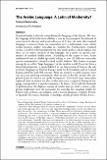Files in this item
The Arabic language : a Latin of modernity?
Item metadata
| dc.contributor.author | Kamusella, Tomasz Dominik | |
| dc.date.accessioned | 2018-01-08T11:30:24Z | |
| dc.date.available | 2018-01-08T11:30:24Z | |
| dc.date.issued | 2017-12 | |
| dc.identifier | 251883644 | |
| dc.identifier | b9b3b007-4263-411f-88d6-aac51e811e65 | |
| dc.identifier | 85040464415 | |
| dc.identifier.citation | Kamusella , T D 2017 , ' The Arabic language : a Latin of modernity? ' , Journal of Nationalism, Memory and Language Politics , vol. 11 , no. 2 , pp. 117-145 . https://doi.org/10.1515/jnmlp-2017-0006 | en |
| dc.identifier.issn | 2570-5857 | |
| dc.identifier.other | ORCID: /0000-0003-3484-8352/work/42102721 | |
| dc.identifier.uri | https://hdl.handle.net/10023/12443 | |
| dc.description.abstract | Standard Arabic is directly derived from the language of the Quran. The Arabic language of the holy book of Islam is seen as the prescriptive benchmark of correctness for the use and standardization of Arabic. As such, this standard language is removed from the vernaculars over a millennium years, which Arabic-speakers employ nowadays in everyday life. Furthermore, standard Arabic is used for written purposes but very rarely spoken, which implies that there are no native speakers of this language. As a result, no speech community of standard Arabic exists. Depending on the region or state, Arabs (understood here as Arabic speakers) belong to over 20 different vernacular speech communities centered around Arabic dialects. This feature is unique among the so-called “large languages” of the modern world. However, from a historical perspective, it can be likened to the functioning of Latin as the sole (written) language in Western Europe until the Reformation and in Central Europe until the mid-19th century. After the seventh to ninth century, there was no Latin-speaking community, while in day-to-day life, people who employed Latin for written use spoke vernaculars. Afterward these vernaculars replaced Latin in written use also, so that now each recognized European language corresponds to a speech community. In future, faced with the demands of globalization, the diglossic nature of Arabic may yet yield a ternary polyglossia (triglossia): with the vernacular for everyday life; standard Arabic for formal texts, politics, and religion; and a western language (English, French, or Spanish) for science, business technology, and the perusal of belles-lettres. | |
| dc.format.extent | 325852 | |
| dc.language.iso | eng | |
| dc.relation.ispartof | Journal of Nationalism, Memory and Language Politics | en |
| dc.subject | Arabic | en |
| dc.subject | Vernaculars | en |
| dc.subject | Holy book | en |
| dc.subject | Diglossia | en |
| dc.subject | Speech community | en |
| dc.subject | Latin | en |
| dc.subject | Modernity | en |
| dc.subject | Polyglossia | en |
| dc.subject | Standard language | en |
| dc.subject | P Language and Literature | en |
| dc.subject | T-NDAS | en |
| dc.subject.lcc | P | en |
| dc.title | The Arabic language : a Latin of modernity? | en |
| dc.type | Journal article | en |
| dc.contributor.institution | University of St Andrews. School of History | en |
| dc.identifier.doi | 10.1515/jnmlp-2017-0006 | |
| dc.description.status | Peer reviewed | en |
This item appears in the following Collection(s)
Items in the St Andrews Research Repository are protected by copyright, with all rights reserved, unless otherwise indicated.

